Data Center RFID Market Size
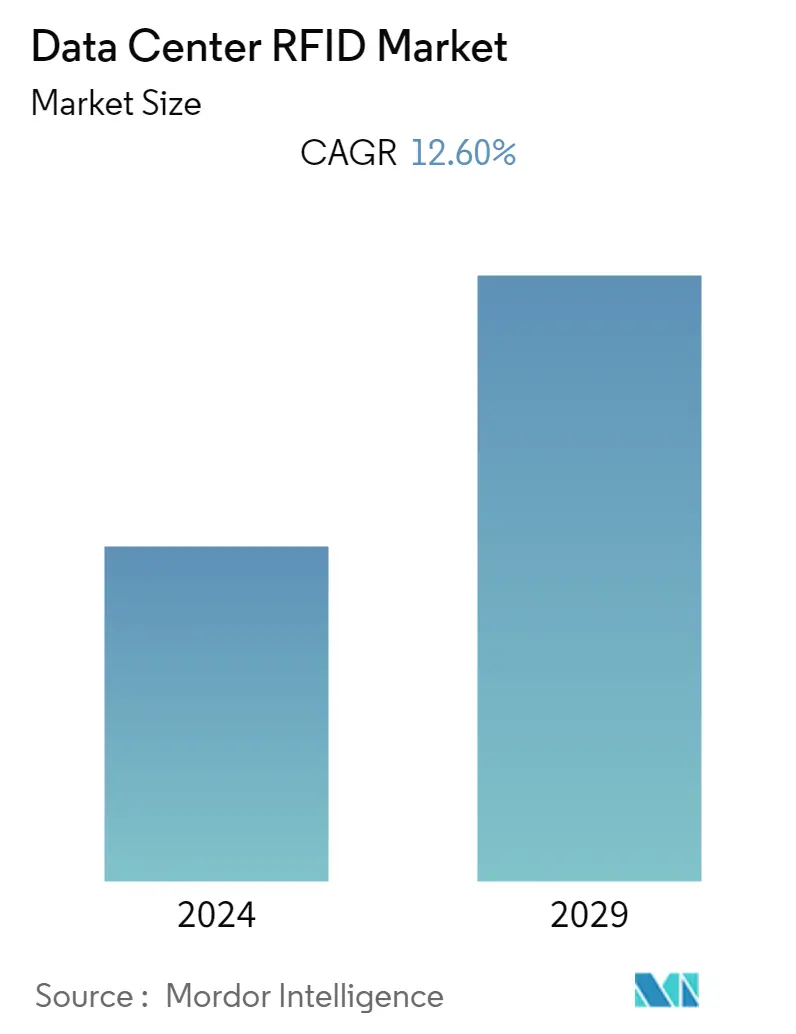
| Study Period | 2019 - 2029 |
| Base Year For Estimation | 2023 |
| CAGR | 12.60 % |
| Fastest Growing Market | Asia-Pacific |
| Largest Market | North America |
| Market Concentration | Low |
Major Players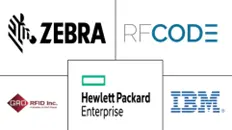
*Disclaimer: Major Players sorted in no particular order |
Data Center RFID Market Analysis
The Global Data Center RFID Market is expected to grow at a CAGR of 12.6% for the next five years. The sector's expansion is attributed to several causes, including the increasing need for data centers globally and the requirement for real-time asset information to lower associated risks.
- Data centers are important resources for contemporary life. The growth and popularity of the internet, mobile devices, and the Internet of Things (IoT) create a large quantity of information and data storage capacity. Asset management is made possible with the use of radio frequency identification (RFID), which also provides a way to boost productivity and save costs.
- Managers of data centers' RFID systems are constantly under continual demand to increase asset security while assuring effective resource usage. Also, data center administrators are concerned about increased data and information risks. Because of this, they are employing RFID technology to identify crucial assets, including servers, routers, and other IT assets.
- The upfront cost of deploying an active RFID system may be greater than deploying a comparable passive RFID solution due to the higher cost of active RFID tags compared to passive ones. However, with time, this price differential often becomes less important or disappears altogether. Passive RFID systems need regular, expensive labor hours as a continuing yearly investment to activate the tags and get the data they give manually.
- For logistics and transportation companies, real-time data and constant communication are essential. The profitability and customer service increase with a successful Proof of Delivery solution. Without having to hire more staff, it can keep consumers constantly updated about the progress of their orders. The entire delivery cycle may be controlled electronically on the back of signature capture functionality, saving many hours of paper pushing.
- The Covid-19 pandemic also compelled retailers to employ RFID on a broader scale by accelerating the already-progressing trend of digital transformation. To survive, omnichannel retail strategies that cater to client requirements across all sales channels become essential. RFID increases merchants' awareness of inventory across all their locations, the company, and distribution facilities to keep up with constantly shifting consumer needs.
Data Center RFID Market Trends
This section covers the major market trends shaping the Data Center RFID Market according to our research experts:
Major Use In the Transport and Logistic Sectors
- According to Digital Reality, the transportation and logistics industry is under tremendous pressure to maintain its competitiveness, provide high-quality customer service, and create novel methods to optimize its operations to meet the demands of its more affluent consumer bases.
- With the ability to always track a vehicle's location on a map owing to RFID tags affixed to the vehicle, managers are better able to locate assets at any time, which greatly improves efficiency. This lowers costs and boosts productivity since businesses can watch their fleet of cars, plan routes effectively for quicker deliveries, and keep a lookout for maintenance concerns that may occur during a journey so they can be rectified before they become greater difficulties.
- Users may use RFID technology with a WMS to improve product tracking speed, simplicity, and accuracy. Employees can use an RFID scanner to scan each pallet of merchandise entering a warehouse and add the new stock to the WMS. Employees may scan items and bin numbers as they are put away in the warehouse to allow location tracking. Additionally, pickers may scan each RFID tag as they choose items, marking the product as having left the distribution center after scanning each RFID tag.
- The ideal method for an easy drive on public roads is FASTag. There is no need to stop at the toll booths to pay for anything with cash if your car has a FASTag. The toll fee or VAT is deducted straight from the associated prepaid account to your FASTag. A gadget called FASTag uses Radio Frequency Identification (RFID) technology to make toll payments immediately while the car is moving.
- In the previous fiscal year, toll income from roads across India was estimated to be worth close to INR 285 billion (USD 3.4 billion). Since the fiscal year 2017, there has been an upward trend in these revenues. One of the causes of this may be the lengthening of the roads that were subject to tolling over the observed time frame.
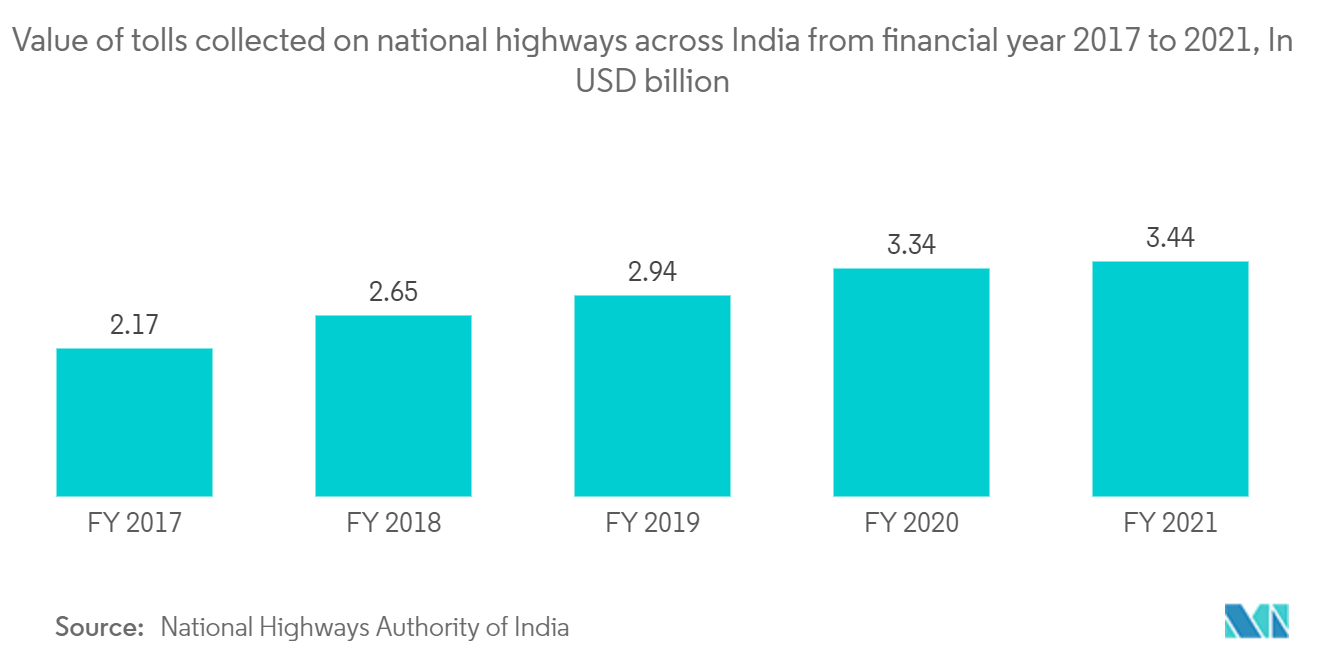
North America Holds a Majority Share
- North America is the market with the largest Data Center RFID share. The region holds more than approximately one-third of the total global market. Data centers are expanding in this region due to their growing digitalization, making it a developing market for data center RFID. Some of the top participants in the worldwide RFID industry are IBM Corporation, Zebra Technologies, and Hewlett-Packard.
- North America has one of the highest telecommunication and IT services adoption rates. Widespread network coverage and world-class mobile penetration are also causing growth in demand for RFID-enabled solutions for data centers infrastructure across the region. Additionally, growing knowledge of the benefits of RFID technology will encourage growth.
- Furthermore, North America now controls the entire RFID industry due to the region's growing need for the storing and tracking solutions provided by RFID. Last year, North America led the worldwide RFID tag market, and this is projected to continue throughout the forecast period. This is a result of regional government programs to encourage the usage of RFID tags expanding. Regional market expansion is likely aided by the growing retail and logistics industries.
- Infrastructure and transportation networks are essential to the growth of the economies of the United States and Canada. Numerous social and economic advantages of efficient transportation networks include more employment, more access to the market, and more investments. As a result, the transportation sector must adjust quickly to technological changes. RFID-based automated toll collection enables toll fees to be electronically collected.
- As of January last year, there were 2,701 data centers in the United States, while Germany had 487. With 456 data centers, the United Kingdom came in third place after China and the United States.
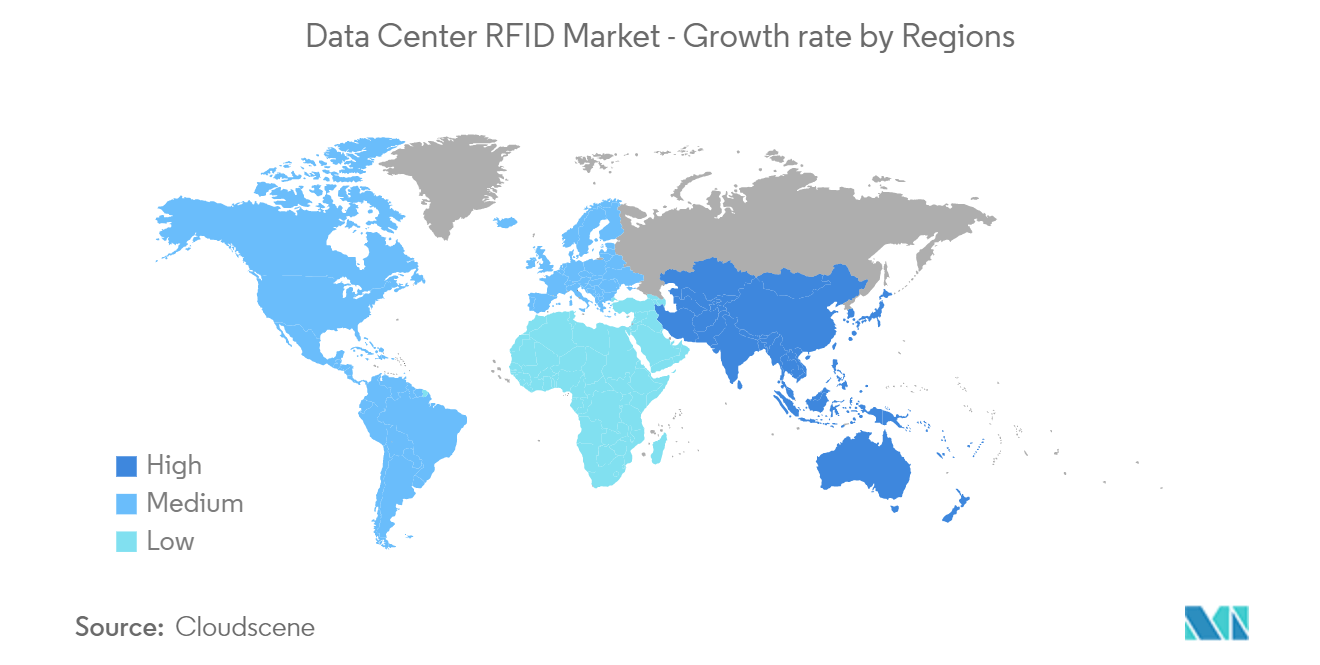
Data Center RFID Industry Overview
The Data Center RFID Market Software Market is fragmented as it currently consists of many players. Several key players in the market are in constant efforts to bring advancements. A few prominent companies are entering into collaborations and expanding their global footprint in developing regions to consolidate their positions in the market. The major player in this market includes IBM Corporation, ZEBRA Technologies, Hewlett Packard Enterprise, GAO RFID RF Code, and several others.
In October 2022, RF Code, a leader in automated, real-time environmental monitoring and physical asset lifecycle management systems, announced significant upgrades to CenterScape, its flagship asset lifecycle management and environmental monitoring platform. The creative changes support the RF Code's goal of giving IT firms real-time knowledge, control, and predictability over operational risks, costs, and compliance in data centers, colocation facilities, and edge facilities.
In October 2022, HP disclosed that Its researchers have developed RFID asset tracking technology for data centers and tested it successfully with Meijer Inc., a supermarket chain across the midwestern United States. The RFID technology, created by HP Labs, can track and audit servers, networking hardware, and storage enclosures in real-time while automatically monitoring data center assets.
Data Center RFID Market Leaders
-
IBM Corporation
-
ZEBRA Technologies
-
Hewlett Packard Enterprise
-
GAO RFID
-
RF Code
*Disclaimer: Major Players sorted in no particular order
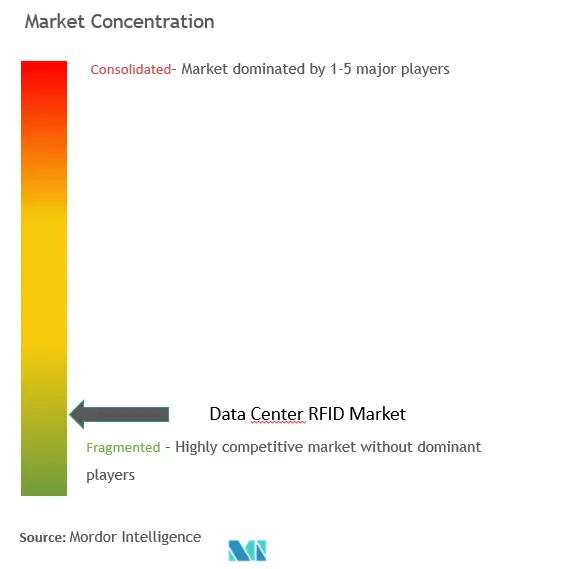
Data Center RFID Market News
- In October 2022, Zebra Technologies unveiled that it would establish a brand-new Research and Development (R&D) facility in Bagmane Solarium City in Bangalore, which is anticipated to be Zebra's largest in the Asia Pacific (APAC). Zebra's new R&D center in Bangalore, about 250,000 square feet (sq. ft.), would house two of the company's current research centers.
- In October 2022, IBM Corporation disclosed that it had expanded its software-defined storage platform that allows IBM to create a unified experience from the edge to the core to the cloud. IBM would add Red Hat storage product roadmaps and Red Hat associate teams to the IBM Storage business unit.
Data Center RFID Market Report - Table of Contents
1. INTRODUCTION
- 1.1 Study Assumptions and Market Definition
- 1.2 Scope of the Study
2. RESEARCH METHODOLOGY
3. EXECUTIVE SUMMARY
4. MARKET INSIGHTS
- 4.1 Market Overview
-
4.2 Industry Attractiveness-Porter's Five Forces Analysis
- 4.2.1 Bargaining Power of Suppliers
- 4.2.2 Bargaining Power of Consumers
- 4.2.3 Threat of New Entrants
- 4.2.4 Threat of Substitute Products
- 4.2.5 Intensity of Competitive Rivalry
- 4.3 Impact of COVID-19 on the Data Center RFID Market Industry
5. MARKET DYNAMICS
-
5.1 Market Drivers
- 5.1.1 Demand for RFID Software Services in Transport and Logistics Sector
- 5.1.2 Growing Telecom and IT Infrastructure Across the Globe
-
5.2 Market Restraints
- 5.2.1 Rising Technical and Manpower Cost
6. MARKET SEGMENTATION
-
6.1 By Vertical
- 6.1.1 Telecom and IT
- 6.1.2 Government and Public
- 6.1.3 Transport and Logistics
- 6.1.4 Retail
- 6.1.5 Media and Entertainment
- 6.1.6 Other Verticals
-
6.2 By Geography
- 6.2.1 North America
- 6.2.2 Europe
- 6.2.3 Asia Pacific
- 6.2.4 Latin America
- 6.2.5 Middle East and Africa
7. COMPETITIVE LANDSCAPE
-
7.1 Company Profiles
- 7.1.1 IBM Corporation
- 7.1.2 ZEBRA Technologies
- 7.1.3 Hewlett Packard Enterprise
- 7.1.4 GAO RFID
- 7.1.5 RF Code
- 7.1.6 Alien Technology Corporation
- 7.1.7 Avery Dennison
- 7.1.8 Omni-ID, Ltd.
- 7.1.9 Casia Apps
- 7.1.10 Impinj, Inc.
- *List Not Exhaustive
8. INVESTMENT ANALYSIS
9. FUTURE TRENDS
** Subject To AvailablityData Center RFID Industry Segmentation
Data Center RFID, also known as DC-RFID, is a technology that employs Radio Frequency Identification to track, keep an eye on, and control any device that is situated inside the physical confines of a data center.
The Data Center RFID Market is Segmented by Vertical (Telecom and IT, Government and Public, Transport and Logistics, Retail, and Media and Entertainment) and Geography (North America, Europe, Asia Pacific, Latin America, and the Middle East and Africa). The market sizes and forecasts are provided in terms of value (USD million) for all the above segments.
| By Vertical | Telecom and IT |
| Government and Public | |
| Transport and Logistics | |
| Retail | |
| Media and Entertainment | |
| Other Verticals | |
| By Geography | North America |
| Europe | |
| Asia Pacific | |
| Latin America | |
| Middle East and Africa |
Data Center RFID Market Research FAQs
What is the current Data Center RFID Market size?
The Data Center RFID Market is projected to register a CAGR of 12.60% during the forecast period (2024-2029)
Who are the key players in Data Center RFID Market?
IBM Corporation, ZEBRA Technologies, Hewlett Packard Enterprise, GAO RFID and RF Code are the major companies operating in the Data Center RFID Market.
Which is the fastest growing region in Data Center RFID Market?
Asia-Pacific is estimated to grow at the highest CAGR over the forecast period (2024-2029).
Which region has the biggest share in Data Center RFID Market?
In 2024, the North America accounts for the largest market share in Data Center RFID Market.
What years does this Data Center RFID Market cover?
The report covers the Data Center RFID Market historical market size for years: 2019, 2020, 2021, 2022 and 2023. The report also forecasts the Data Center RFID Market size for years: 2024, 2025, 2026, 2027, 2028 and 2029.
Data Center RFID Industry Report
Statistics for the 2023 Data Center RFID market share, size and revenue growth rate, created by Mordor Intelligence™ Industry Reports. Data Center RFID analysis includes a market forecast outlook to 2029 and historical overview. Get a sample of this industry analysis as a free report PDF download.



